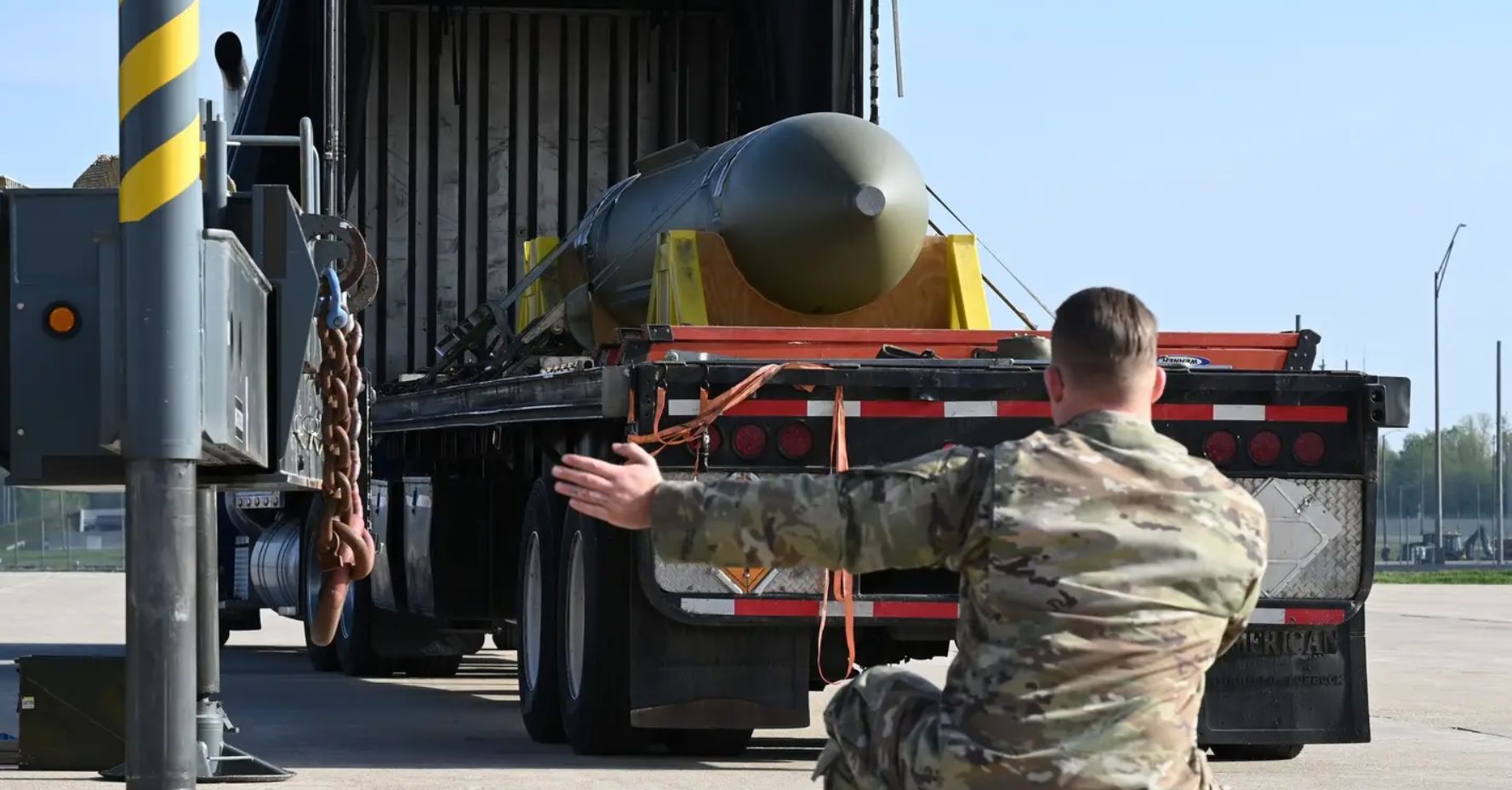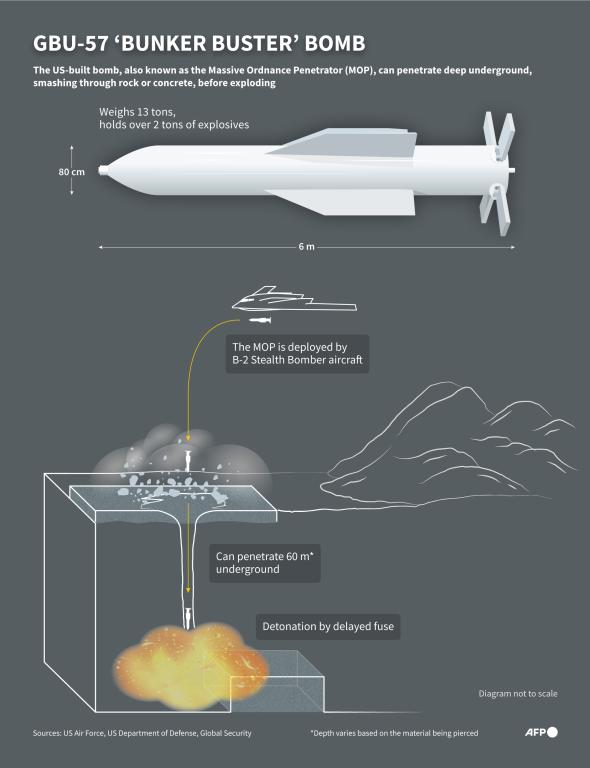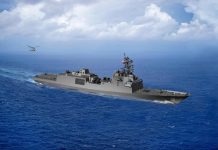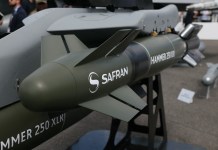On June 22, the US dropped 14 GBU-57 Massive Ordnance Penetrator (MOP), also known as bunker buster bombs, on two Iranian nuclear sites – Fordow and Natanz.
As many as 12 GBU-57 bombs were dropped on Fordow and two on Natanz.
Though GBU-57 MOP bombs were developed in the 2010s, this was the first combat use of these 30,000-pound bunker buster bombs that can penetrate 200 feet (60 meters) before exploding.
Now, the Pentagon office that helped design and develop these bombs is waiting for comprehensive battle damage assessment (BDA) reports to analyze the impact of the bunker buster bombs and their success in dismantling the Iranian underground nuclear facilities.
The Defense Threat Reduction Agency (DTRA) will then use this data from BDA reports to further improve the bunker-buster bombs. Notably, the US is already working on a successor to this unique munition, as reported by the EurAsian Times earlier.
Not Nuclear Or TNT, China’s H-Bomb May Spark Global Firestorm; Here’s Why It’s Much More Destructive
Officially named the Next Generation Penetrator (NGP), the new-age bunker buster bomb will be compatible with the B-21 Raider, the US’s next-generation stealth bomber planned as a replacement for the B-2 Spirit bomber.

The NGP is envisioned as a more advanced version of the GBU-57 MOP. It can also have an attached rocket booster for stand-off strike capabilities, and the ability to deliver precision strikes within a Circular Error Probable (CEP) of 7.2 feet (2.2 meters), in both GPS-aided, degraded, and denied environments.
Furthermore, the US Air Force (USAF) is also interested in a Global Precision Attack Weapon (GPAW) bunker buster bomb, which is small enough to be fitted in the internal weapons bay of stealth fighters like the F-35.
The BDA reports from Fordow and Natanz are critical for designing these new-age bunker-buster bombs and for making improvements to GBU-57 MOP.
Damage Assessment
The GBU-57 is a unique munition. The only one of its kind in the whole world, a bomb that can penetrate 200 feet before exploding.
After launching Operation Rising Lion on June 13, Israel realized that it could not destroy Iran’s Fordo nuclear site unless the US helped with GBU-57 MOP bombs, as the Fordow facility was buried nearly 250 feet under the hard rock.
The convergence between GBU-57 capability and Fordow’s depth is not a coincidence. It happened because, for years, GBU-57 MOP was designed with just one thing in mind: Iran’s Fordow nuclear facility.
In a detailed press briefing last month, Air Force Gen. Dan Caine, Chairman of the Joint Chiefs of Staff, explained how for “more than 15 years” a DTRA officer and his teammate “lived and breathed this single target, Fordow, a critical element of Iran’s covert nuclear weapons program. He studied the geology. He watched the Iranians dig it out. He watched the construction, the weather, the discard material, the geology, the construction materials, where the materials came from. He looked at the vent shaft, the exhaust shaft, the electrical systems, the environmental control systems, every nook, every crater, every piece of equipment going in and every piece of equipment going out.”

Once the GBU-57 MOP was built, the US military had another challenge. How to test the capabilities of this bunker buster bomb?
“Obviously, we did not build Fordow in the United States and test it,” a senior defense official (SDO) told reporters on June 10.
“What we do try to do is test in what we call a threat-representative environment, and in this case, we built a test site to test the munitions against in collaboration with the Air Force and DTRA test organization to try to ascertain the effects that the MOP would have in certain environments. We’ve continued to do tests over time to then determine what those effects are, and then we use that information to support our modeling and simulation programs,” the SDO said.
However, despite these multiple tests, the DTRA had to wait more than a decade before the bomb was tested against the target for which it was built – Iran’s Fordow nuclear site.
And now, the DTRA officials are anxiously awaiting the detailed BDA report to analyze the impact of the bomb and make improvements.
“We deeply anticipate the intelligence community completing BDA on this so that we can assess the models vice what actually happened according to their analysis,” the SDO was quoted as saying by TWZ.
We will “take a look at how accurate the projections were, so we can use information there to improve our modeling output and our targeting decision support packages that we put together,” the SDO said.
It will help us “to assess whether or not the weapon performed as planned, according to the BDA.”
These results “may go into future iterations of the technology… We’re constantly evolving and trying to leverage new technology as we do, so we will take this information and determine; ‘did things work the way that we wanted them to?’ In which case, how can we continue to improve upon it, or did things not work exactly as planned? And how can we fix that so that in the future, our next generation capabilities work that much better? We don’t have that information yet, but we look forward to receiving it so that it can inform our next investments in this arena.”
Testing any weapon in a real-world situation is crucial for assessing its actual capabilities and making further improvements.
In this instance, the DTRA had to wait more than one decade to test the weapon in a real-world situation. However, there is another interesting story from the US military history, where a weapon, in fact, the most destructive weapon ever built, was launched to check its performance in actual combat.
The Nuclear Attack Compulsion After The Successful Trinity Test
On July 16, 1945, the world’s first nuclear explosion occurred when a plutonium implosion device was tested at a site near Los Alamos, New Mexico. Code-named Trinity, this was the world’s first successful nuclear test. The world now had a powerful new weapon.
But, there was still a small issue. Nuclear weapons were designed and developed for Nazi-ruled Germany. However, Germany had already surrendered two months before the Trinity test.

Though the Trinity test was a success, Americans still wanted to test the new weapon in a real-world situation.
On July 18, barely two days after the Trinity test, General Leslie Groves, head of the Manhattan Project, wrote in a memo to Secretary of War Henry Stimson:
“The test [at Trinity] was successful beyond the most optimistic expectations… However, no one can tell what the effect will be when it is used on a city, and we are all anxious to find out.”
General Groves did not have to wait too long. Less than three weeks after this memo, imploring the US administration to test the weapon on a (real) city, the US dropped a nuclear bomb on the Japanese city of Hiroshima on August 6, 1945. Three days later, on August 9, another nuclear bomb was dropped on Nagasaki.
While the Hiroshima bomb was a uranium-based gun-type design, in Nagasaki, a plutonium-based implosion design was tested. The field data from these blasts impacted not only the future development of nuclear bombs but also left a deep mark on the design and development of nuclear-capable bomber aircraft.
The story is revealing in that it tells us that even after multiple tests, military officials always prefer testing their weapons systems in real-world scenarios to assess their strengths and shortcomings and to make further improvements.
Now that the GBU-57 MOP has finally been used more than a decade after the bomb was built, the US officials are eagerly waiting damage assessment reports to make improvements to the bunker buster bomb.
- Sumit Ahlawat has over a decade of experience in news media. He has worked with Press Trust of India, Times Now, Zee News, Economic Times, and Microsoft News. He holds a Master’s Degree in International Media and Modern History from the University of Sheffield, UK.
- VIEWS PERSONAL OF THE AUTHOR.
- He can be reached at ahlawat.sumit85 (at) gmail.com




